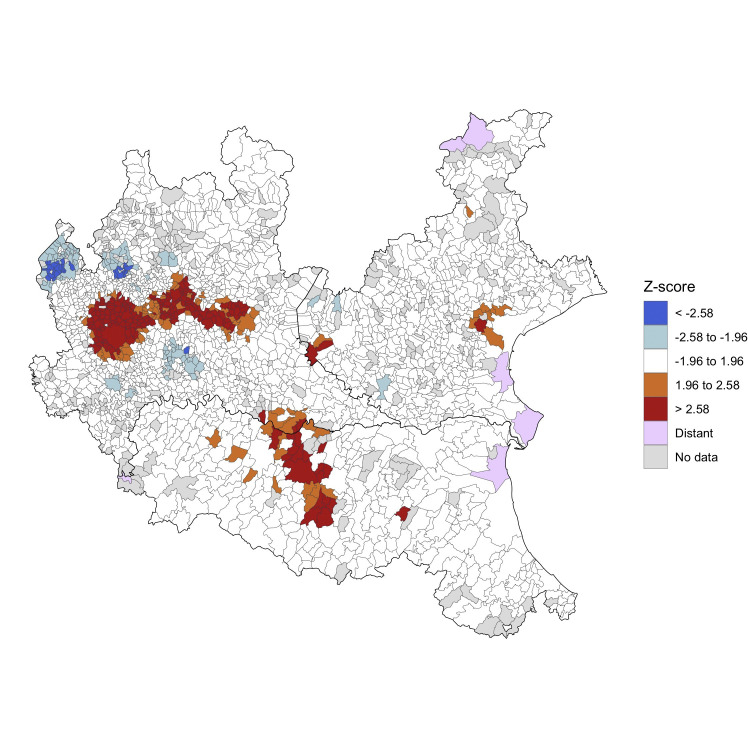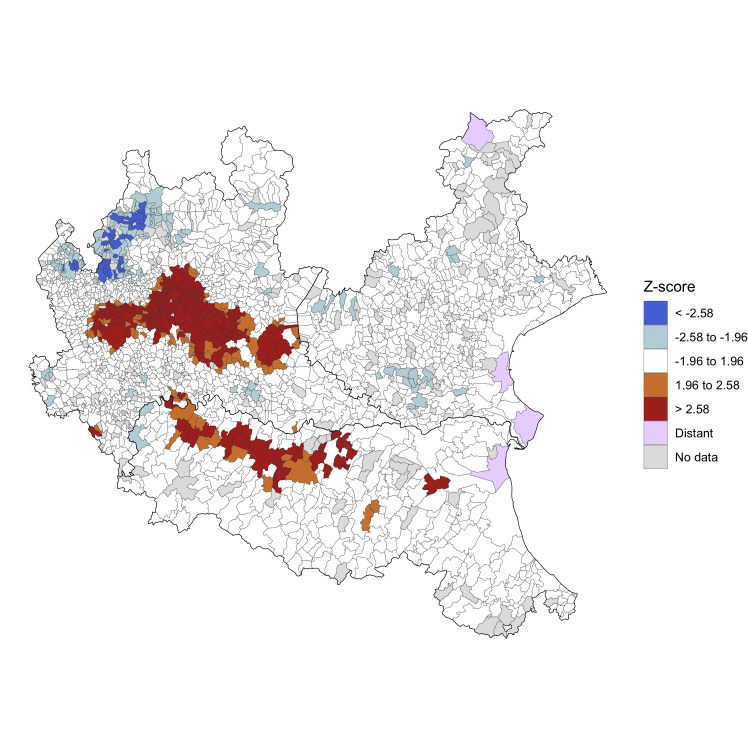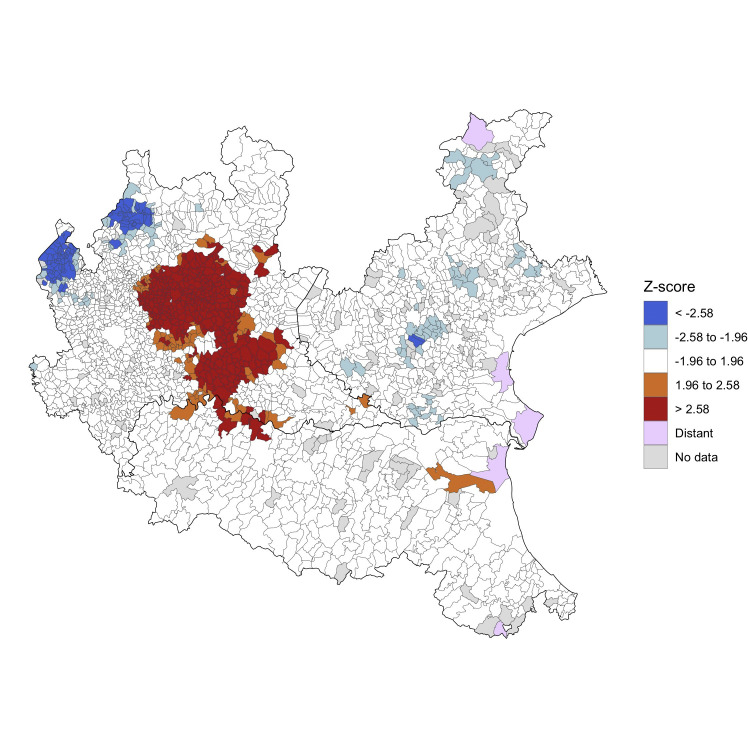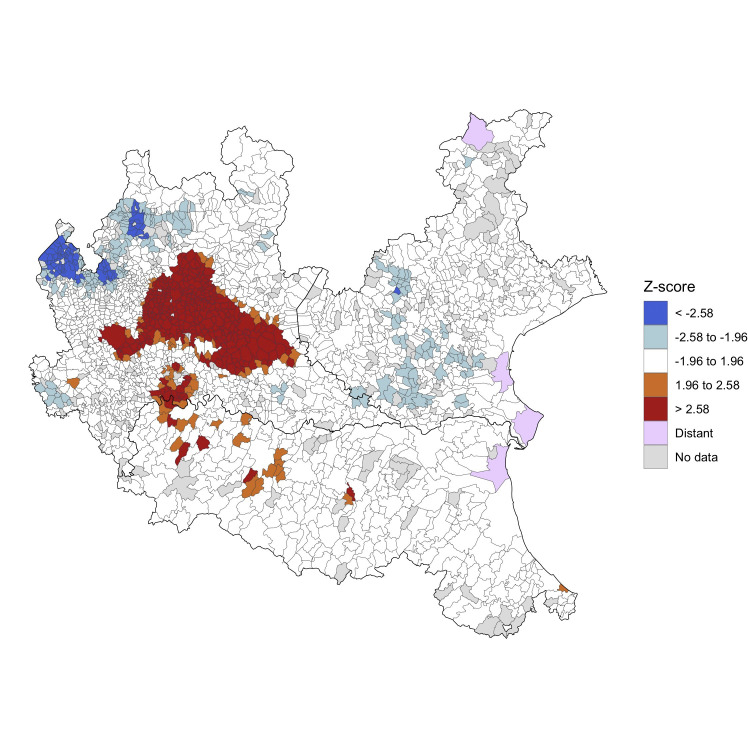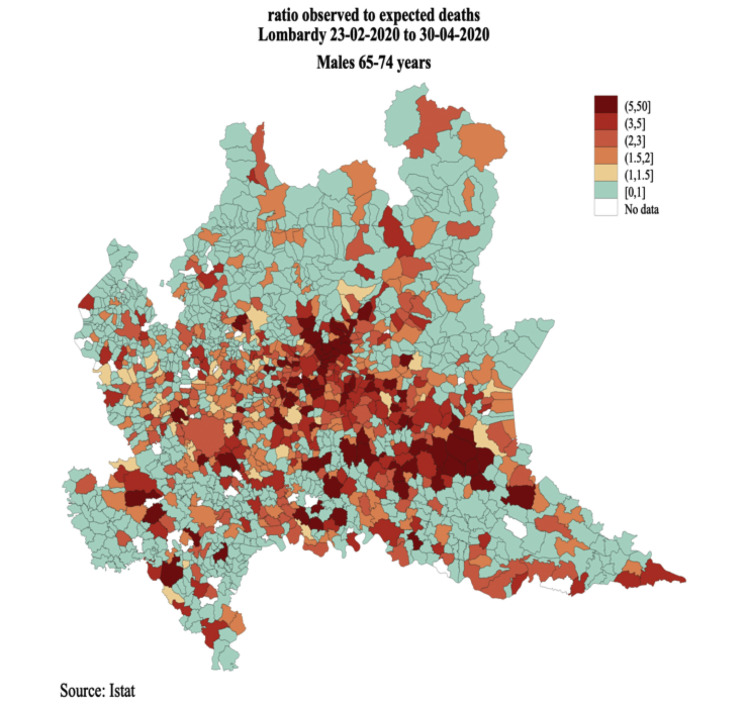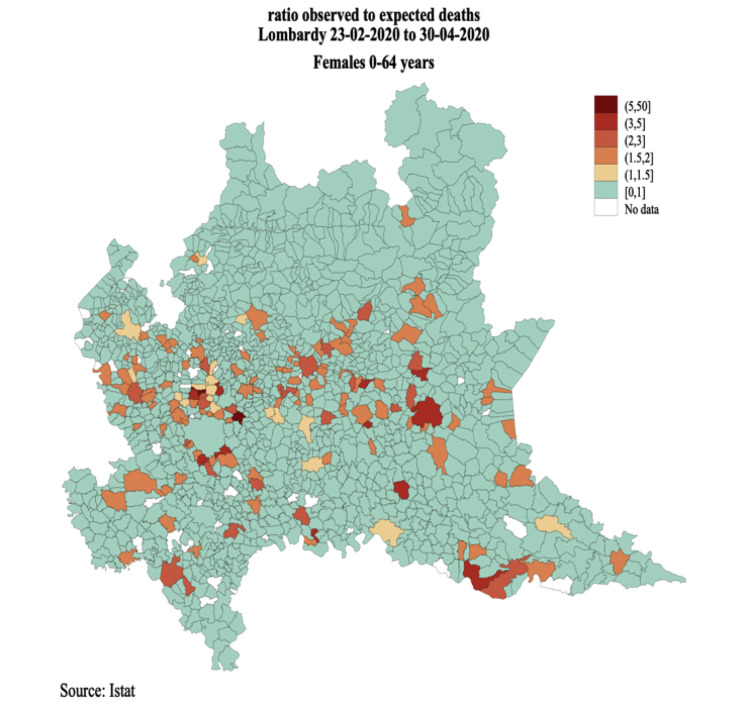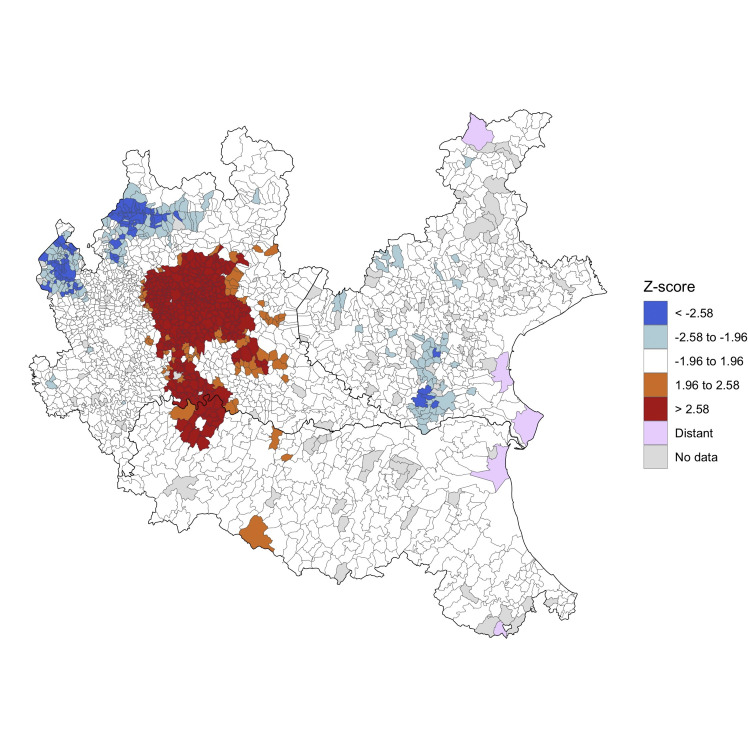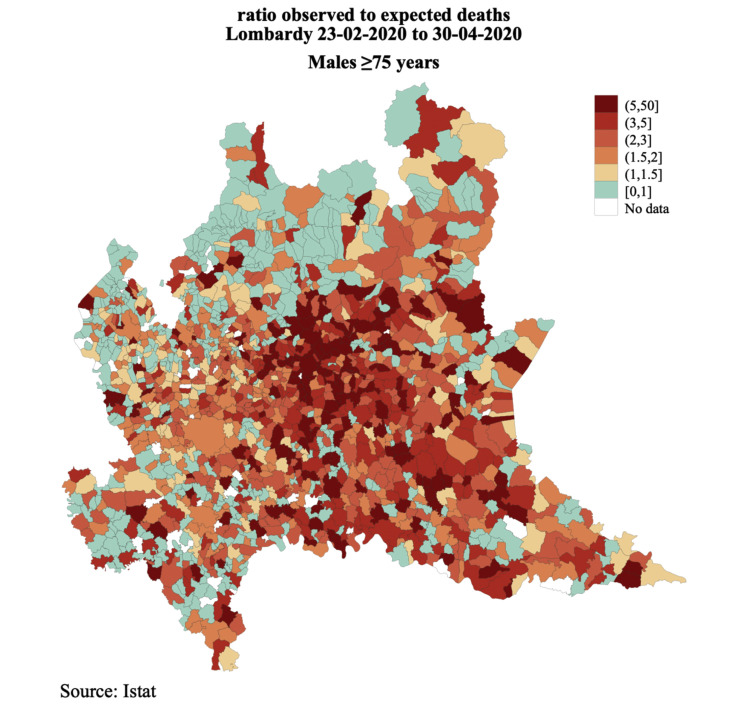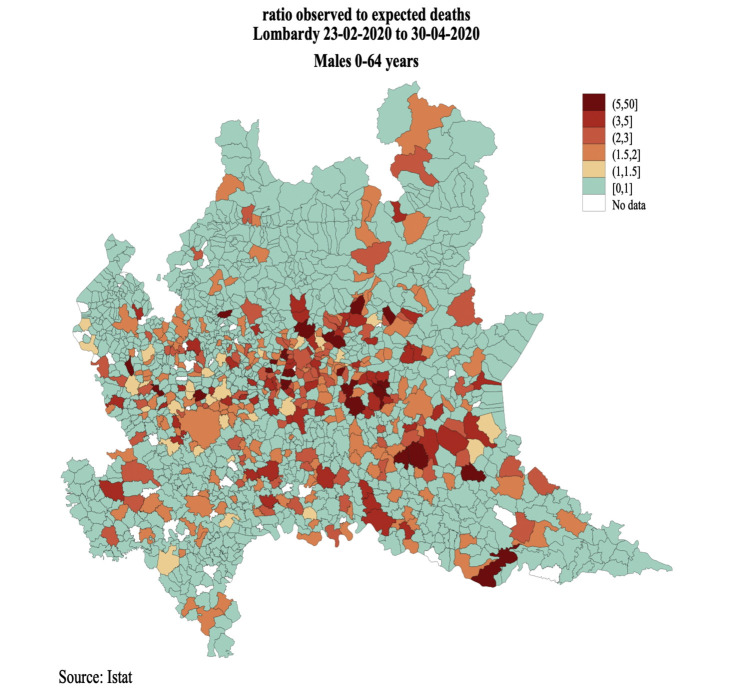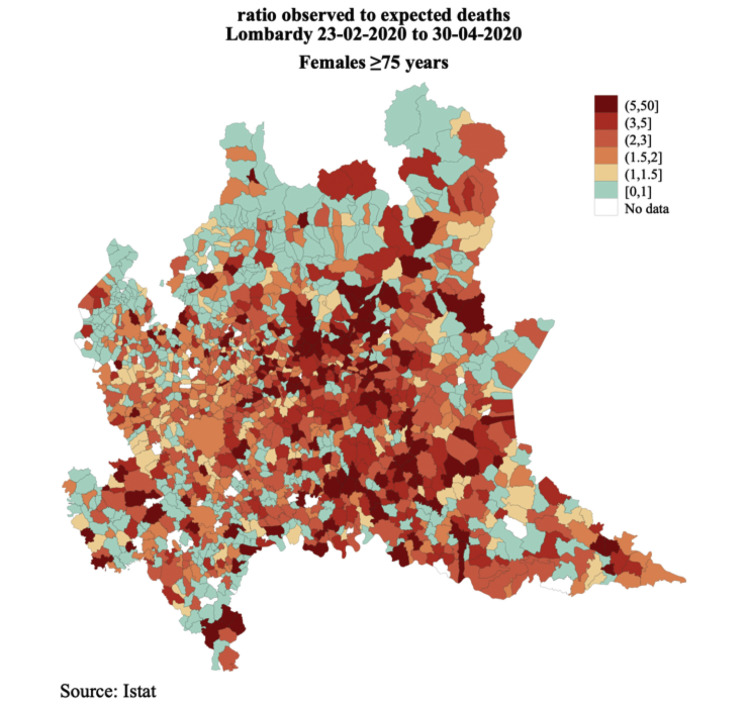Abstract
The impact of Coronavirus Disease 2019 (COVID-19) on mortality in Italy has been described at the regional level, while less is known about mortality in municipalities, although the spatial distribution of COVID-19 in its first wave has been uneven.
We aimed to describe the excess mortality due to COVID-19 from February 23rd to April 30th, 2020 in the three most affected Italian regions, in age and gender subgroups within each municipality.
Excess mortality varied widely among municipalities even within the same region; it was higher among the elderly and higher in males except in the ≥75 age group. Thus, nearby municipalities may show a different mortality burden despite being under common regional health policies, possibly as a result of local reinforcements of regional policies.
Identifying the municipalities where mortality was higher and the pathways used by the virus to spread may help to concentrate efforts in understanding the reasons why this happened and to identify the frailest areas in light of recurrences of the epidemic.
Keywords: Excess mortality, COVID-19, Italy, Municipalities, Regions
1. Background
As of May 10, 2020, 4,051,431 confirmed cases of and 279,734 deaths from Coronavirus Disease 2019 (COVID-19), a respiratory infectious disease caused by the Severe Acute Respiratory Syndrome - Coronavirus 2 (SARS-CoV-2), were reported worldwide, affecting 187 countries (Center for Systems Science and Engineering (CSSE) at Johns Hopkins University (JHU), 2020). Among Western countries, Italy was the first severely affected. The first case of local transmission of COVID- 19 was confirmed in a 38-year-old man in the municipality of Codogno (Lombardy region) on February 19, 2020 (Odone et al., 2020). On February 21 a resident of Vo’, a small town near Padua (Veneto region), died of pneumonia due to SARS-CoV-2 infection (Crisanti and Cassone, 2020; Lavezzo et al., 2020). On February 23 the Italian government created two red zones quarantining 50,000 people living in ten towns, including Codogno and Vo’.
Despite these containment measures, SARS-CoV-2 rapidly spread not only in the Lombardy and Veneto region, but also in some areas of the bordering Emilia-Romagna region. It became clear that, without appropriate measures, SARS-CoV-2 would have spread dangerously all over Italy. This prospect convinced the government to lockdown the whole country on March 10, 2020, when confirmed cases were 10,149 and deaths 631 (Italian Civil Protection Department, 2020). At first, only some commercial activities were closed; on March 22, the government proceeded to instruct the closure of all productive activities, except for those necessary to produce essential goods. As of May 10, 2020, official cases in Italy were 219.070 (Italian Civil Protection Department, 2020), while deaths from COVID-19 reached 30.560. During the first wave COVID-19 had an extremely varied distribution in Italy, mainly because of the commercial dynamism of the locations of the first epicenters, geographical differences in population density, distribution of healthcare facilities, presence of community services and locally defined strategies to contain/mitigate its spreading. As a matter of fact, in Italy regions must provide the so called “Essential Levels of Care” (i.e. the core benefit package and standard of health services), set by the central government, through the Regional Health Service (RHS), but they are responsible and autonomous for the local organization and delivery of health care (Lenzi et al., 2013). In each region, the municipalities followed the general indications given by the Regional Government, but with different scaling up strategies at the local level.
Deaths from COVID-19 as reported by official data may be underestimated because of various factors, among which the classification of cause of death when the deceased suffered from other preexisting conditions and the absence of post-mortem testing among those who have died before they could receive a diagnostic confirmation. For this reason, the most reliable method to estimate COVID-19 related mortality to date is to calculate the excess all-cause mortality occurred during the COVID-19 outbreak compared to all-cause mortality in the same period in the previous years (Bilinski and Emanuel, 2020; Vestergaard et al., 2020; Woolf et al., 2020a, 2020b; Zylke and Bauchner, 2020).
The Italian National Institute of Statistics (ISTAT), called on by researchers and local administrators, promptly released and regularly updated the data on confirmed deaths (Italian Istitute for National Statistics (ISTAT), 2020a). The first studies (Colombo and Impicciatore, 2020; Mancino, 2020) performed on these data reported higher excess mortality mainly in the municipalities closer to the SARS-CoV-2 outbreak epicenters, such as those in Lombardy. Most of these studies (Bucci et al., 2020; Buonanno et al., 2020; Modi et al., 2020) aimed to infer excess mortality at the regional or national level, but all of them had to acknowledge the caveats implied by relying on incomplete data to draw such predictions. Other studies, utilizing data provided by the heat waves surveillance systems collected only in a limited number of municipalities (Davoli et al., 2020), provided conflicting results, without showing a particular excess of mortality.
Importantly, excess mortality was not evenly distributed over the national territory and at the regional and municipality level (Biggeri et al., 2020; Davoli et al., 2020; Italian Istitute for National Statistics (ISTAT), 2020a; Italian Istitute for National Statistics (ISTAT) and Italian Superior Institute of Health (ISS), 2020a, 2020b, 2020c; Mancino, 2020; ScienzaInRete, 2020). In fact, some municipalities seemed unaffected by the epidemic, with a number of deaths equal to or even lower than that related to the same period of the previous years, while in others the number of deaths was estimated between 6 and 10 times higher.
Therefore, the aim of our study was to describe the spatial and demographic distribution of excess mortality due to COVID-19 in the three most affected Italian regions, by estimating excess mortality in subgroups defined by gender and age classes within each municipality with available data.
2. Methods
We conducted a longitudinal study using the data provided by the Italian Institute of Statistics (ISTAT) on June 4, 2020, which include the daily number of deaths available for 7270 Italian municipalities (92.0% out of the 7904 municipalities) (Italian Istitute for National Statistics (ISTAT), 2020a, 2020b) grouped by gender and age classes in the period from January 1 to April 30 of the years 2015–2020. The municipalities with available data were 1464/1506 (97.2%) in Lombardy, 506/563 (89.9%) in Veneto and 304/328 (92.7%) in Emilia-Romagna.
Excess mortality (EM) was estimated for each municipality in six subgroups defined by gender and three age classes consistent with data provided by ISTAT (0–64, 65–74 and ≥ 75 years) in the time period from February 23, 2020 to April 30, 2020. In each subgroup of each municipality, a simple linear regression was conducted with the observed deaths as dependent variable and an ordinal variable indicating year as independent (coded 0 to 4 to represent years from 2015 to 2019). The constant and slope obtained were used to estimate by extrapolation the expected number of deaths in 2020, using the equation: Exp.D. = a + b*5, where x = 5 corresponds to year 2020. The result of the equation was rounded to the nearest integer. We preferred using linear regression over Poisson regression to estimate the expected mortality, because we verified that the latter fails in providing affordable estimates for small municipalities with extremely irregular patterns of mortality in the five years used for prediction, which we expect to happen in about 3% of the municipalities. The expected mortality estimation was set to 0 when linear regression provided a negative estimate as a result of a decreasing trend in mortality. The ratio of observed deaths in 2020 divided by 1.012 (a coefficient that corrects for 2020 being a leap year) to expected deaths in 2020 gives the relative mortality (RM) experienced by each age/gender subgroup for each municipality. Excess mortality was then obtained by subtracting 1 from the RM and multiplying this value by 100. When observed deaths and/or expected deaths were = 0, the following corrections were applied: 1) If expected deaths = 0 and observed deaths>0, then RM = observed deaths; 2) if observed deaths = 0 and expected deaths >0, then RM = 0; 3) if observed and expected deaths were = 0, then RM = 0.
To summarize the impact of COVID-19, we reported for each age and gender subgroup within regions the median, mean and maximum relative mortality, and compared them among regions and age classes using ANOVA with Scheffé post-hoc analyses, and between genders using t-test.
We also reported the percentage of municipalities that showed an excess mortality (separating those under +50%, which could include also not anomalous increases of mortality, from those over +50%) and how many showed a lower than expected mortality.
Relative mortality ratios were displayed using choropleth maps of the three Italian regions considered, in order to visually identify the areas that suffered the greatest burden of COVID-19 mortality during the epidemic and the municipalities where a reduction in mortality was observed. We drew side by side regional maps of two age groups (0–64, ≥75 years) to visually compare the differences in RM.
Lastly, we calculated spatial autocorrelation to identify global clustering with Global Moran test, and local autocorrelation between municipalities using Getis-Ord Gi statistic. The resultant z-scores ≥|1.96| identify statistically significant spatial clusters of high values (hot spots) and low values (cold spots) of excess mortality. This analysis was carried out on the three regions of Lombardy, Veneto and Emilia-Romagna taken together in order to identify potential interregional clusters. The map of local autocorrelation calculated for the males ≥75 years group is displayed in the paper and the maps of the other five age-gender subgroups are included in the supplementary materials.
Stata v.15.1 (StataCorp; College Station, TX, USA) was used for EM estimates and specifically spmap procedure (Pisati, 2008) was used to draw choropleth maps; spatial analyses were carried out using the spdep R package (Mendez, 2020; R Core Team, 2020). A freely accessible GitHub repository has been specifically created at https://github.com/COVID-19-related-excess-mortality/Excess-Mortality to collect all the maps produced for this analysis and those of the other Italian regions.
3. Results
Relative mortality during the COVID-19 outbreak exhibited a very composite pattern among the three examined regions, and among age classes and genders (Table 1 ). Generally, Lombardy experienced the highest burden of mortality, and Veneto the lowest. Mean EM for people aged ≥75 years in Lombardy was +170% for males and +157% for females, in both cases significantly higher than those found in Emilia-Romagna (+115% for males and +100% for females), and Veneto (+56% for males and +46% for females). In the other age-gender subgroups, Lombardy and Emilia-Romagna had similar EM, significantly higher than those found in Veneto, except for females aged 0–64. In the three regions, females displayed an excess mortality only among those aged ≥75 years. Males in age groups 65–74 and ≥ 75 had excess mortality in the three regions, except for the age group 65–74 in Veneto. Differences of EM by gender (SM1, Table 1) were found only in the 0–64 and 65–74 age classes, in which EM was higher in males (differences significant at p < 0.001 in all regions), while among people aged ≥75 EM was similar between males and females. In particular, in the 0–64 and 65–74 age groups the EM of males was about twofold compared to females in Lombardy. People aged ≥75 years had the highest excess mortality in all regions and gender subgroups and those aged 0–64 years had always the lowest EM (SM1, Table 2).
Table 1.
Relative mortality in municipalities (age-gender subgroups) during the COVID-19 epidemic (February 23rd to April 30th).
| LOMBARDY (n = 1464) |
VENETO (n = 506) |
EMILIA-ROMAGNA (n = 304) |
ANOVA (F; p-value) | Post-hoc (Scheffé) | |||||||
|---|---|---|---|---|---|---|---|---|---|---|---|
| Median | Mean | Max | Median | Mean | Max | Median | Mean | Max | |||
| 0-64y Females | 0 | 0.53 | 5.93 | 0 | 0.47 | 6 | 0 | 0.62 | 4.94 | 3.02; 0.049 | none |
| 0-64y Males | 0.99 | 1.08 | 9.88 | 0.47 | 0.69 | 5.93 | 0.99 | 1.16 | 11.86 | 17.90; <0.001 | V < ER, L |
| 65-74y Females | 0.74 | 0.90 | 13 | 0 | 0.53 | 4.94 | 0.99 | 1.07 | 11.86 | 23.61; <0.001 | V < ER, L |
| 65-74y Males | 1 | 1.80 | 22 | 0.99 | 0.89 | 6.92 | 1 | 1.62 | 8.89 | 38.96; <0.001 | V < ER, L |
| ≥75y Females | 1.98 | 2.57 | 30.64 | 1 | 1.46 | 13.84 | 1.48 | 2.00 | 11.86 | 43.21; <0.001 | V < ER < L |
| ≥75y Males | 1.98 | 2.70 | 27 | 1.19 | 1.56 | 11 | 1.51 | 2.15 | 18 | 39.31; <0.001 | V < ER < L |
Overall, excess mortality affected a larger proportion of municipalities in Emilia-Romagna (45.6%) than in Lombardy (41.5%) and in Veneto (27.9%). However, in Lombardy there was a higher number of municipalities that suffered EM >50% in older people (SM1, Table 3).
Concerning individual municipalities (SM2), the highest EM was estimated in the municipality of Capriolo (25 km east from Bergamo, in Lombardy, with 9512 residents as of January 1, 2020) in females aged ≥75 (+2964%), with 31 deaths occurred against 1 expected. In the major towns, Bergamo (Lombardy) displayed a +429% EM in males aged ≥75 (337 deaths against 63 expected), +382% EM in males aged 65–74, +332% EM in females aged 65–74 and + 254% EM in females aged ≥75; Piacenza (Emilia-Romagna) had +1086% EM in males aged 0–64 (36 deaths against 3 expected), +355% in males 65–74 and + 231% EM in males ≥75. Among the regional capitals, Venezia (Veneto) did not show EM (relative mortality between 0.85 and 1.25), Bologna (Emilia-Romagna) experienced EM rates between +46% and +68%, while Milano (Lombardy) had an EM of +126% in males aged 65–74 and an EM between +50% and +85% in the other groups, except for females aged 0–64 that showed a negative EM of −8%.
Examination of the Lombardy map for men aged ≥75 (Fig. 1 ) confirmed that the municipalities of Bergamo, Brescia, Cremona and Lodi provinces, corresponding to the central and eastern part of the region, experienced the highest EM. The “green” municipalities with a mortality reduction are mainly located in the peripheral areas of the region which are more distant and less connected to the epidemic epicenters. In men aged 0–64 this pattern is less visible (Fig. 1), because most municipalities did not experience an EM for this age group. Differently from Lombardy, a geographical pattern of epidemic spread for males aged ≥75 is not clearly visible in Veneto (Fig. 2 ), as municipalities with EM seem to be scattered in different areas, intertwined with “green zones”. Moreover, in men aged 0–64 few municipalities displayed an EM. The western Verona province, bordering Lombardy, was not the most hit by mortality within the region. From these maps we can argue that Veneto successfully isolated itself from the potential epidemic flow coming from the nearby region.
Fig. 1.
Relative mortality in males aged 0–64 (left) and ≥75 years (right) in Lombardy region. Municipalities are depicted with different colors according to the magnitude of their excess mortality. Green refers to municipalities with a relative mortality ≤1, that is when observed deaths are lower than or equal to the expected deaths. When relative mortality is > 1, increasing saturation of red is used, to reflect increasing values of relative mortality. No data municipalities are those for which no data was released by ISTAT or that had no deaths for the examined age-gender subgroups in any year between 2015 and 2020.
Fig. 2.
Relative mortality in males aged 0–64 (left) and ≥75 years (right) in Veneto region. Municipalities are depicted with different colors according to the magnitude of their excess mortality. Green refers to municipalities with a relative mortality ≤1, that is when observed deaths are lower than or equal to the expected deaths. When relative mortality is > 1, increasing saturation of red is used, to reflect increasing values of relative mortality. No data municipalities are those for which no data was released by ISTAT or that had no deaths for the examined age-gender subgroups in any year between 2015 and 2020.
As for the Emilia-Romagna region (Fig. 3 ), it is evident for both age groups an EM north-south gradient from the area bordering the Lodi and Cremona provinces of Lombardy, following the trajectory of the main regional route that connects almost all the major regional centers. Moreover, one local hot spot of COVID-19 can be seen in the east of the region, spreading from the municipality of Medicina, and another local critical area might be noticed in the southernmost municipalities, bordering the Pesaro province of the Marche region, where another known hot spot was located. Similarly to Lombardy and Veneto, EM in the ≥75 age group was remarkably higher than in the 0–64 age group.
Fig. 3.
Relative mortality in males aged 0–64 (left) and ≥75 years (right) in Emilia-Romagna region. Municipalities are depicted with different colors according to the magnitude of their excess mortality. Green refers to municipalities with a relative mortality ≤1, that is when observed deaths are lower than or equal to the expected deaths. When relative mortality is > 1, increasing saturation of red is used, to reflect increasing values of relative mortality. No data municipalities are those for which no data was released by ISTAT or that had no deaths for the examined age-gender subgroups in any year between 2015 and 2020.
Comparing the epidemic period with the first five weeks of the year, in the large majority of municipalities of Lombardy and Emilia-Romagna, and to a lesser extent in Veneto, mortality in 2020 before the COVID-19 outbreak was lower than expected (data not shown). This trend has been observed in many countries worldwide (EuroMOMO, 2020a; 2020b; Michelozzi et al., 2020; Vestergaard et al., 2020).
Global autocorrelation expressed by the Moran I statistic calculated on Lombardy, Veneto and Emilia-Romagna taken together ranged from 0.104 for females aged 0–64 to 0.289 for males aged 65–74. In the local autocorrelation map for the males ≥75 years group (Fig. 4 ) a large hot spot is clearly identified in the Bergamo area, extending eastward to Brescia and southward to the Piacenza area in Emilia-Romagna. No hot spots were identified in Veneto. Large cold spots were found in the bordering areas to the north and northwest of Lombardy and in the southern area of Veneto. Interestingly, hot spots of EM for the other two age classes (Supplementary materials, local correlation maps) seem to follow in Lombardy an east-west direction which is superimposable to the main traffic routes connecting Milan, Bergamo and Brescia. The cold spots in northwestern Lombardy were consistently found in all six age-gender subgroups.
Fig. 4.
Local autocorrelation expressed by the standardized Getis-Ord Gi statistic for relative mortality in males ≥75 years old of Lombardy, Veneto and Emilia-Romagna. High positive values of the z-scores (in red) denote spatially correlated municipalities with high values of excess mortality. High negative values of the z-scores (in blue) denote spatially correlated municipalities with low values of excess mortality. Distant municipalities are those for which the Getis-Ord Gi* was not computed due to the large distance of their centroids from those of the nearest neighboring municipalities with available data. No data municipalities are those for which no data was released by ISTAT or that had no deaths for the examined age-gender subgroups in any year between 2015 and 2020.
4. Discussion
In this study we found that excess mortality due to the first wave of COVID-19 in Italy had an uneven spatial and demographic distribution in the most affected regions of Lombardy, Emilia-Romagna and Veneto, and within each region between the different municipalities.
Our study highlighted that COVID-19 related EM was similar between males and females for the ≥75 age group, while in the other age groups it was higher in males. Several studies on the characteristics of patients have clarified that SARS-CoV-2 has a higher rate of severe clinical manifestations and mortality among older people. However, gender and pre-existing conditions such as diabetes, obesity and cardiovascular diseases could also have played an important role (Italian Superior Institute of Health, 2020; Onder et al., 2020; Qiu et al., 2020).
The spread of COVID-19 epidemic clearly originated from specific areas and initially affected the surrounding municipalities. As shown by our findings, the main epicenter of the first wave in Italy can be identified in the Bergamo area. This area, in the north east of Lombardy, has plenty of industrial and commercial activities, whose economy is intertwined with the European and Chinese ones. A second “hot zone” surrounds Piacenza (Emilia-Romagna), a town 16 km away from Codogno, where the first case of local transmission was found in Italy. The town is an important railway junction and the starting point of the Via Emilia, the ancient commercial Roman road that runs through the Po River valley (Pianura Padana) from Piacenza to Rimini (Adriatic coast) passing through Parma, Reggio Emilia, Modena, Bologna and Forlì. Previous publications have demonstrated how the epidemic circulated across cities and regions through the main commercial and commuting routes (Adnkronos, 2020; CremonaOggi, 2020; Gloria, 2020; Maietti et al., 2020; Sebastiani, 2020; Signorelli et al., 2020). Areas distant from these epicenters most likely benefited from the lockdown measures enforced nationwide before the epidemic spread could massively reach them.
The different RHS organizations must be taken into account when analyzing the responses to the epidemic. Lombardy has a Regional Health System based on a strong hospital-centered approach, with many excellences in secondary and tertiary care. The Veneto region has an RHS with a solid primary care level; Emilia-Romagna is somewhere in between, but its health care system is more similar to the one in Veneto (Cicchetti et al., 2020; Usuelli, 2020). When SARS-CoV-2 started spreading in Vo’, the RHS in Veneto and the policies adopted at the regional and local level allowed a quick reaction. Adopting mainly a community-based approach, multiple actions were taken at once: the municipality of Vo’ was immediately declared a red zone, massive testing, although at the beginning of the outbreak test capacity is usually low (Ruan, 2020), isolation of cases, rapid contact tracing. In Vo’ all people, also the asymptomatic, were tested (Crisanti and Cassone, 2020; Lavezzo et al., 2020). Importantly, Veneto largely relied on home care assistance, limiting hospital admissions to the most severe cases, and started early testing of healthcare workers operating in the community and in hospitals. In Emilia-Romagna as well the community-based approach was used to contrast the epidemic, but Piacenza, where the first outbreak of the region was registered, originating from the nearby hot spot of Codogno, ended up as one of the most affected municipalities in Italy during the first wave of the pandemic. Probably the virus had already extensively spread when the first case was found, and the community services were not equipped to promptly react, being overwhelmed by the high volumes of contemporary cases. Also, it could be that the municipality was not quickly declared a red zone, when there was the suspicion that the number of cases still undetected might have been dangerously high. Nevertheless, the Emilia-Romagna RHS was able to adapt, and following the same approach used by Veneto started being more effective in mitigating the spread of the virus. Specifically, home care assistance and an active surveillance system were implemented, relying on general practitioners with phone calls to patients to monitor their symptoms.
On the contrary, the organizational structure of the RHS in Lombardy that promotes a hospital centered approach at the expenses of the community-based services, may have contributed to exacerbate the criticalities presented by COVID-19 (Usuelli, 2020). Thereto, the region did not address the outbreak adopting the same plan in municipalities experiencing similar circumstances: while the towns around Lodi were quickly declared red zones when the first cases were identified, successfully containing the spread of the virus, the virus outbreak in a hospital in the province of Bergamo did not lead to the establishment of a confinement, that was implemented only when the national lockdown was enforced (De Luca, 2020). This contributed to make the Bergamo area one of the most hit areas in Europe. Especially at the beginning of the epidemic, people were still admitted to hospitals. The dramatic flow of patients saturated the intensive care units, forcing doctors to decide how to allocate resources (Rosenbaum, 2020). In the hospital setting, the virus was spread not only by patients, but also by healthcare workers, who could not always rely on appropriate personal protective equipment risking their lives while doing their job.
Analyzing the death toll in Lombardy, Veneto and Emilia-Romagna, we argue that the best way to address epidemics is through proactive medicine at a community-based level, opposite to reactive medicine at a hospital level. Moreover, to foster discussions and more in-depth analysis on the EM due to COVID-19 infections, we hypothesized several factors that could have equally affected the infections and mortality in the three regions: household transmission, which led to the most vulnerable being exposed when a family member got the infection; use of public transportation; congestion of the healthcare system; late diagnosis of healthcare workers for COVID-19; limited number of executed swabs; inadequate contact tracing; inadequate community-based interventions.
At the regional level, the difference in adopted strategies certainly reflects the different RHS's organizations and operational approaches. In tackling the epidemic, the Veneto and Lombardy regions adopted two opposite strategies regarding, for example, the recommendations on testing. As of April 30, Veneto performed 71.1 swabs per 1000 population (4,905,854 inhabitants) and, whenever possible, tested also asymptomatic people; Lombardy (10,060,574 inhabitants) performed 37.4 swabs per 1000 population, testing mainly patients with more severe clinical symptoms, as instructed by the Italian Ministry of Health in that moment. On this topic, Emilia-Romagna had a more similar approach to Lombardy, performing 41.0 swabs per 1000 population on a total population of 4,459,477 inhabitants (Italian Civil Protection Department, 2020; Italian Institute for National Statistics (ISTAT), 2020c; Onder et al., 2020; Italian Istitute for National Statistics (ISTAT) and Italian Superior Institute of Health (ISS), 2020c).
At the local level, the reason of higher COVID-19 mortality in some specific municipalities can be debated, as several causes other than the distance from the hot spots or a possible bias in estimation or some casual local factors might be involved. Possible explanations for a marked difference in excess mortality between close municipalities could be the presence of gathering places (i.e. sport venues, cinemas), of industrial/commercial activities, care and nursing homes or of particular events that may have taken place before the lockdown. In the municipality of Medicina (Emilia-Romagna), a gathering at a bowls club was the cause of the rapid spread of the virus; almost all the people present got infected, and all but one died. Medicina immediately became a red zone (Emilia- Romagna Region, 2020), successfully narrowing the afflicted area. This demonstrates that it is important to contrast the spread of the virus at the smallest possible level and in the most accurate possible way.
Several municipalities showed a lower increase of COVID-19 related deaths or even a reduced mortality. This can be likely attributed to a smaller incidence of deaths for causes such as accidents or occupational injuries, favored by the lockdown (Zylke and Bauchner, 2020). On the other hand, the high mortality figures especially for people aged ≥75 may also have been increased by the lower incidence of influenza observed in Italy in the last winter compared to last year, which left more elderly people exposed to COVID-19 (Bella, 2020; Michelozzi et al., 2020).
Our study suggests that the difference in the response to the epidemic can be the result of policies adopted both at the regional and at the municipality level. Most of the studies conducted on this epidemic (Bucci et al., 2020; Buonanno et al., 2020; Modi et al., 2020; ScienzaInRete, 2020) have tried to explain its course considering the regional policies. As an added value, in the present study we explored also the pattern of the epidemic within regions and noticed that, net of regional policies, even nearby municipalities showed different excess mortality rates. Accordingly, the causes of such differences should be sought not only at the national and the regional policies, but also in local factors which cannot be brought to light if data are analyzed as regional or higher aggregates. Therefore, focusing on the regional and municipality level could be more helpful than a regional level analysis alone and we advocate that our approach may help to shed some light on the areas where the death toll was highest and thus trigger further investigations on some specific/local dynamics of the outbreak.
Our study presents some limitations. First, although data on mortality was available for more than 92% of municipalities, our analysis was based on incomplete territorial coverage, therefore our conclusions could have been partially different if complete data were available. We used linear regression to derive a mortality trend from 5 years, which could not always be adequate as it may be leveraged by anomalous mortality figures in the first or in the last year of the time interval used for prediction, especially in small territorial units. By using linear regression, we intended to capture a trend in mortality where it exists, and in these cases its prediction is more accurate than the projection of the average mortality observed in the previous five years. In addition, we reduced potential confounding by estimating excess mortality within subgroups defined by age class and gender. Nevertheless, our results should be considered as provisional estimates until official data of verified quality covering all municipalities will be released and made available to researchers for further investigations.
5. Conclusions
Our study demonstrates that nearby municipalities within each region may show highly different mortality levels, despite being under common regional health policies, therefore further studies are necessary to analyze more in depth the local determinants of COVID-19 spread. Analyzing mortality at the regional and subregional level is of paramount importance as also suggested by the recent European Commission document.
Our approach could be used to generate or to confirm hypotheses regarding the flow of epidemics starting from the main originating sites, and to detect affected loci that are distant from these initial affected areas. Identifying the municipalities where the mortality burden was higher and the pathways used by the virus to spread may help to concentrate efforts in understanding the reasons why this happened and to identify the frailest areas in case of the occurrence of a second epidemic outbreak. Whether higher excess mortality depended on lack of preparedness, or on a particularly old age structure, or on inefficacy in the enforcement of containment measures, this should lead to different types of interventions in the preparation of a possible second wave of COVID-19.
The phase of coexistence with the virus will be as challenging as the phase of the outbreak. An adequate organization of the health services is imperative.
Availability of data and material
Data are publicly available.
Ethics approval
Not applicable.
Funding
This research did not receive any specific grant from funding agencies in the public, commercial, or not-for-profit sectors.
Declaration of competing interest
None.
Footnotes
Supplementary data to this article can be found online at https://doi.org/10.1016/j.healthplace.2021.102508.
Appendix A. Supplementary data
The following are the Supplementary data to this article:
Fig. S1.
Fig. S2.
Fig. S3.
Fig. S4.
Fig. S5.
Fig. S6.
Fig. S7.
Fig. S8.
Fig. S9.
Fig. S10.
Fig. S11.
Fig. S12.
References
- Adnkronos Il matematico: “Virus ha viaggiato in autostrada sui tir” [online] 2020. https://www.adnkronos.com/fatti/cronaca/2020/04/12/matematico-virus-viaggiato-autostrada-sui- tir_D0v4m2iPjmBghbr1hskyqJ.html URL.
- Bella A. 2020. Rapporto Epidemiologico InfluNet - Stagione Influenzale 2019-2020 - Settimana 2020-14. [Google Scholar]
- Biggeri A., Catelan D., Braga M., Lagazio C., Barbone F. A municipality-level analysis of excess mortality in Italy in the period January-April 2020. Epidemiol. Prev. 2020 doi: 10.19191/EP20.5-6.S2.130. https://repo.epiprev.it/1911 E&P Repository. [DOI] [PubMed] [Google Scholar]
- Bilinski A., Emanuel E.J. COVID-19 and excess all-cause mortality in the US and 18 comparison countries. J. Am. Med. Assoc. 2020;7:19–21. doi: 10.1001/jama.2020.20717. [DOI] [PMC free article] [PubMed] [Google Scholar]
- Bucci E., Leuzzi L., Marinari E., Parisi G., Ricci-Tersenghi F. Verso una stima di morti dirette e indirette per Covid [online] Scienzainrete. 2020 https://www.scienzainrete.it/articolo/verso-stima-di-morti-dirette-e-indirette-covid/enrico-bucci- luca-leuzzi-enzo-marinari URL. 10.13.20. [Google Scholar]
- Buonanno P., Galletta S., Puca M. Estimating the severity of COVID-19: evidence from the Italian epicenter. PloS One. 2020;15 doi: 10.1371/journal.pone.0239569. [DOI] [PMC free article] [PubMed] [Google Scholar]
- Cicchetti, et al. Center for Systems Science and Engineering (CSSE) at Johns Hopkins University (JHU), 2020. 2020. https://systems.jhu.edu/
- Cicchetti A., Damiani G., Specchia M.L., Basile M., Di Bidino R., Di Brino E., Di Paolo M.G., Di Pilla A., Ferrara F.M., Giorgio L., RIccardi M.T., Rumi F., Tattoli A. Piemonte e Lazio; Rome: 2020. Analisi dei modelli organizzativi di risposta al Covid-19. Focus su Lombardia, Veneto, Emilia-Romagna. [Google Scholar]
- Colombo A.D., Impicciatore R. CremonaOggi; Bologna: 2020. La crescita della mortalità ai tempi del Covid-19.https://www.cremonaoggi.it/2020/04/23/virus-corre-sulla-a21-le-province-piu- colpite-attraversate-dallautostrada/ 2020. Il virus corre sulla A21. Le province più colpite attraversate dall’autostrada.[online]. URL. [Google Scholar]
- CremonaOggi . 2020. Il virus corre sulla A21. Le province più colpite attraversate dall’autostrada.https://www.cremonaoggi.it/2020/04/23/virus-corre-sulla-a21-le-province-piu- colpite-attraversate-dallautostrada/ [Google Scholar]
- Crisanti A., Cassone A. The Guardian; 2020. In One Italian Town, We Showed Mass Testing Could Eradicate the Coronavirus [online], 20 March. [Google Scholar]
- Davoli M., Sario M. De, Michelozzi P., Noccioli F., Rossi P., Scortichini M. 2020. Andamento della Mortalità Giornaliera (SiSMG ) nelle città italiane in relazione all’epidemia di Covid-19. [Google Scholar]
- De Luca D.M. 2020. Il disastro in Val Seriana - Il post [online], 1 April. Il Post. [Google Scholar]
- Emilia-Romagna Region . 2020. Coronavirus, chiuso il comune di Medicina (Bo): contagio troppo elevato, non è possibile uscire e entrare Ordinanza.https://www.regione.emilia-romagna.it/notizie/2020/marzo/coronavirus-chiuso-il-comune-di-medicina [Google Scholar]
- EuroMOMO . 2020. European Mortality Bulletin, Week 14, 2020. Copenhagen. [Google Scholar]
- EuroMOMO Maps and Graphs [online] 2020. https://www.euromomo.eu/graphs-and-maps URL.
- Gloria S. 2020. “È l’epidemia della A21”: così il virus si è spostato lungo l’autostrada da Brescia a Torino.https://www.fanpage.it/attualita/e-lepidemia-della-a21-cosi-il-virus-si-e-spostato-lungo-lautostrada-da-brescia-a-torino/ [Google Scholar]
- Italian Civil Protection Department Official Italian data about COVID-19 [online] 2020. https://github.com/pcm-dpc/COVID-19 5.12.20. [DOI] [PMC free article] [PubMed]
- Italian Istitute for National Statistics (ISTAT) Official Data about 2015-2020 mortality in Italy [online] 2020. https://www.istat.it/it/archivio/240401 URL.
- Italian Istitute for National Statistics (ISTAT) Official Italian data about the nomenclature of territorial units for statistics [online] 2020. https://www.istat.it/it/archivio/6789 URL.
- Italian Istitute for National Statistics (ISTAT) Official Italian Data about the resident population [online] 2020. http://dati.istat.it/Index.aspx?DataSetCode=DCIS_POPSTRCIT1 URL.
- Italian Istitute for National Statistics (ISTAT), Italian Superior Institute of Health (ISS) 2020. Impatto dell’epidemia COVID-19 sulla mortalità totale della popolazione residente - Primo Trimestre 2020. Rome. [Google Scholar]
- Italian Istitute for National Statistics (ISTAT), Italian Superior Institute of Health (ISS) 2020. Impatto dell’epidemia COVID-19 sulla mortalità totale della popolazione residente periodo nel periodo gennaio-maggio 2020. Rome. [Google Scholar]
- Italian Istitute for National Statistics (ISTAT), Italian Superior Institute of Health (ISS) 2020. Impatto dell’epidemia di COVID-19 sulla mortalità totale della popolazione residente - Primo Quadrimestre 2020. Rome. [Google Scholar]
- Italian Superior Institute of Health . 2020. Caratteristiche dei pazienti deceduti positivi a COVID-19 in Italia - 9 Aprile 2020. Rome. [Google Scholar]
- Lavezzo E., Franchin E., Ciavarella C., Cuomo-Dannenburg G., Barzon L., Del Vecchio C., Rossi L., Manganelli R., Loregian A., Navarin N., Abate D., Sciro M., Merigliano S., De Canale E., Vanuzzo M.C., Besutti V., Saluzzo F., Onelia F., Pacenti M., Parisi S., Carretta G., Donato D., Flor L., Cocchio S., Masi G., Sperduti A., Cattarino L., Salvador R., Nicoletti M., Caldart F., Castelli G., Nieddu E., Labella B., Fava L., Drigo M., Gaythorpe K.A.M., Ainslie K.E.C., Baguelin M., Bhatt S., Boonyasiri A., Boyd O., Cattarino L., Ciavarella C., Coupland H.L., Cucunubá Z., Cuomo-Dannenburg G., Djafaara B.A., Donnelly C.A., Dorigatti I., van Elsland S.L., FitzJohn R., Flaxman S., Gaythorpe K.A.M., Green W.D., Hallett T., Hamlet A., Haw D., Imai N., Jeffrey B., Knock E., Laydon D.J., Mellan T., Mishra S., Nedjati-Gilani G., Nouvellet P., Okell L.C., Parag K.V., Riley S., Thompson H.A., Unwin H.J.T., Verity R., Vollmer M.A.C., Walker P.G.T., Walters C.E., Wang H., Wang Y., Watson O.J., Whittaker C., Whittles L.K., Xi X., Ferguson N.M., Brazzale A.R., Toppo S., Trevisan M., Baldo V., Donnelly C.A., Ferguson N.M., Dorigatti I., Crisanti A. Suppression of a SARS-CoV-2 outbreak in the Italian municipality of Vo’. Nature. 2020;584:425–429. doi: 10.1038/s41586-020-2488-1. [DOI] [PubMed] [Google Scholar]
- Lenzi J., Rucci P., Franchino G., Domenighetti G., Damiani G., Fantini M.P. Regional and gender variation in mortality amenable to health care services in Italy. J. Hosp. Adm. 2013;2:28. doi: 10.5430/jha.v2n3p28. [DOI] [Google Scholar]
- Maietti E., Golinelli D., Fantini M.P. COVID-19 in Italy: did the virus run on an ancient Roman road? J Public Health (Berl.) 2020 doi: 10.1007/s10389-020-01377-x. [DOI] [PMC free article] [PubMed] [Google Scholar]
- Mancino D. 2020. Coronavirus, a marzo anche a Milano la mortalità è raddoppiata [online], 3 April. IlSole24Ore. [Google Scholar]
- Mendez C. RStudio/RPubs; 2020. Spatial autocorrelation analysis in R [online]https://rpubs.com/quarcs-lab/spatial-autocorrelation URL. 10.20.20. [Google Scholar]
- Michelozzi P., De'Donato F., Scortichini M., Pezzotti P., Stafoggia M., De Sario M., Costa G., Noccioli F., Riccardo F., Bella A., Demaria M., Rossi P., Brusaferro S., Rezza G., Davoli M. Temporal dynamics in total excess mortality and COVID-19 deaths in Italian cities. BMC Publ. Health. 2020;20:1325. doi: 10.1186/s12889-020-09398-7. [DOI] [PMC free article] [PubMed] [Google Scholar]
- Modi C., Böhm V., Ferraro S., Stein G., Seljak U. 2020. Total COVID-19 Mortality in Italy: Excess Mortality and Age Dependence through Time-Series Analysis. medRxiv. [DOI] [Google Scholar]
- Odone A., Delmonte D., Scognamiglio T., Signorelli C. COVID-19 deaths in Lombardy, Italy: data in context. Lancet Publ. Health. 2020;5 doi: 10.1016/S2468-2667(20)30099-2. [DOI] [PMC free article] [PubMed] [Google Scholar]
- Onder G., Rezza G., Brusaferro S. Case-fatality rate and characteristics of patients dying in relation to COVID-19 in Italy. JAMA. 2020;323(18):1775–1776. doi: 10.1001/jama.2020.4683. [DOI] [PubMed] [Google Scholar]
- Pisati M. SPMAP: stata module to visualize spatial data. 2008. http://citec.repec.org/rss/bocbocodes456812.xml Stata Help Files.
- Qiu P., Zhou Y., Wang F., Wang H., Zhang M., Pan X., Zhao Q., Liu J. Clinical characteristics, laboratory outcome characteristics, comorbidities, and complications of related COVID-19 deceased: a systematic review and meta-analysis. Aging Clin. Exp. Res. 2020;32:1869–1878. doi: 10.1007/s40520-020-01664-3. [DOI] [PMC free article] [PubMed] [Google Scholar]
- R Core Team R: a language and environment for statistical computing [online] 2020. https://www.R-project.org/ URL.
- Rosenbaum L. Facing covid-19 in Italy — ethics, logistics, and therapeutics on the epidemic’s front line. N. Engl. J. Med. 2020 May 14;382(20):1873–1875. doi: 10.1056/NEJMp2005492. Epub 2020 Mar 18. PMID: 32187459. [DOI] [PubMed] [Google Scholar]
- Ruan S. Likelihood of survival of coronavirus disease 2019. Lancet Infect. Dis. 2020 Jun;20(6):630–631. doi: 10.1016/S1473-3099(20)30257-7. Epub 2020 Mar 30. Erratum in: Lancet Infect Dis. 2020 Apr 6;: PMID: 32240633; PMCID: PMC7156221. [DOI] [PMC free article] [PubMed] [Google Scholar]
- ScienzaInRete . 2020. Mortalità in Italia (1 gennaio - 15 aprile 2020) [online]https://www.scienzainrete.it/articolo/dati-covid-19/2020-04- 19?utm_source=phplist1435&utm_medium=email&utm_content=HTML&utm_campaign=Cronac he+della+ricerca+%23134 URL. [Google Scholar]
- Sebastiani G. Il coronavirus ha viaggiato in autostrada? [online] 2020. https://www.scienzainrete.it/articolo/coronavirus-ha-viaggiato-autostrada/giovanni-sebastiani/2020- 04-09 URL.
- Signorelli C., Odone A., Gianfredi V., Bossi E., Bucci D., Oradini-Alacreu A., Frascella B., Capraro M., Chiappa F., Blandi L., Ciceri F. The spread of COVID-19 in six western metropolitan regions: a false myth on the excess of mortality in Lombardy and the defense of the city of Milan. Acta Bio-Med. Ateneo Parmense. 2020;91:23–30. doi: 10.23750/abm.v91i2.9600. [DOI] [PMC free article] [PubMed] [Google Scholar]
- Usuelli M. The Lombardy region of Italy launches the first investigative COVID-19 commission. Lancet. 2020;6736:19–20. doi: 10.1016/S0140-6736(20)32154-1. [DOI] [PMC free article] [PubMed] [Google Scholar]
- Vestergaard L.S., Nielsen J., Richter L., Schmid D., Bustos N., Braeye T., Denissov G., Veideman T., Luomala O., Möttönen T., Fouillet A., Caserio-Schönemann C., an der Heiden M., Uphoff H., Lytras T., Gkolfinopoulou K., Paldy A., Domegan L., O'Donnell J., de’ Donato F., Noccioli F., Hoffmann P., Velez T., England K., van Asten L., White R.A., Tønnessen R., da Silva S.P., Rodrigues A.P., Larrauri A., Delgado-Sanz C., Farah A., Galanis I., Junker C., Perisa D., Sinnathamby M., Andrews N., O'Doherty M., Marquess D.F., Kennedy S., Olsen S.J., Pebody R., Krause T.G., Mølbak K. Excess all-cause mortality during the COVID-19 pandemic in Europe – preliminary pooled estimates from the EuroMOMO network. Euro Surveill. 2020;25 doi: 10.2807/1560-7917.ES.2020.25.26.2001214. March to April 2 020. [DOI] [PMC free article] [PubMed] [Google Scholar]
- Woolf S.H., Chapman D.A., Sabo R.T., Weinberger D.M., Hill L. Excess deaths from COVID-19 and other causes, march-April 2020. J. Am. Med. Assoc. 2020;324:510. doi: 10.1001/jama.2020.11787. [DOI] [PMC free article] [PubMed] [Google Scholar]
- Woolf S.H., Chapman D.A., Sabo R.T., Weinberger D.M., Hill L., Taylor D.D.H. Excess deaths from COVID-19 and other causes, march-July 2020. J. Am. Med. Assoc. 2020;324:1562. doi: 10.1001/jama.2020.19545. [DOI] [PMC free article] [PubMed] [Google Scholar]
- Zylke J.W., Bauchner H. Mortality and morbidity, the measure of a pandemic. J. Am. Med. Assoc. 2020;324:458. doi: 10.1001/jama.2020.11761. [DOI] [PubMed] [Google Scholar]
Associated Data
This section collects any data citations, data availability statements, or supplementary materials included in this article.
Supplementary Materials
Data Availability Statement
Data are publicly available.







